Mechanism Influencing the Drying Behavior of Bitumen Emulsion
Abstract
:1. Introduction
- To quantitatively study the drying behavior of different bitumen emulsions;
- To evaluate the quality of bitumen emulsions from the drying aspect;
- To reveal the key properties of bitumen emulsion dominating its drying behavior.
2. Materials and Specimens Preparation
2.1. Materials
2.2. Drying Test
2.3. Observation Test of Bitumen Droplets Packing during Drying
3. Methodology to Evaluate the Emulsion Drying
3.1. Theory and Qualitative Description of the Emulsion Drying
- The first stage corresponds to the droplets in the semi-diluted regime when the concentration of the droplets is far from the maximum particle packing fraction in Figure 5a. The bitumen emulsion has a free evaporation surface thus its evaporation rate can be equal to that of pure water or dilute emulsifier solution. This regime ranges from the initial state, ϕ0, to the critical volume fraction of droplets, ϕ1, at which bitumen droplets approach and the irreversible coalescence of bitumen droplets may begin as Figure 5b.
- The second stage corresponds to the compact regime when the increase in the volume fraction of bitumen by evaporation beyond ϕ1 takes place with the further packing, deformation and irreversible coalescence of bitumen droplets. The evaporation rate sharply decreases in this stage because the area of the evaporation surface is getting smaller. This process is determined by the flow out of the water from the gap among the compact droplets until they coalesce to a roughly continuous film as Figure 5d. In this stage, there is a moment such as that demonstrated in Figure 5c when bitumen droplets reach the maximum packing state.
- The final stage corresponds to the diffused regime when the bitumen molecules are inter-diffused among droplets, thus becoming the continuous bitumen phase with the inclusions of the aqueous phase in Figure 5d. The residual water in the film escapes either by diffusion through the capillary channels between the coalescing droplets or extrusion due to the reconfiguration of the bitumen phase. In this stage, the evaporation rate is much smaller and tends to zero.
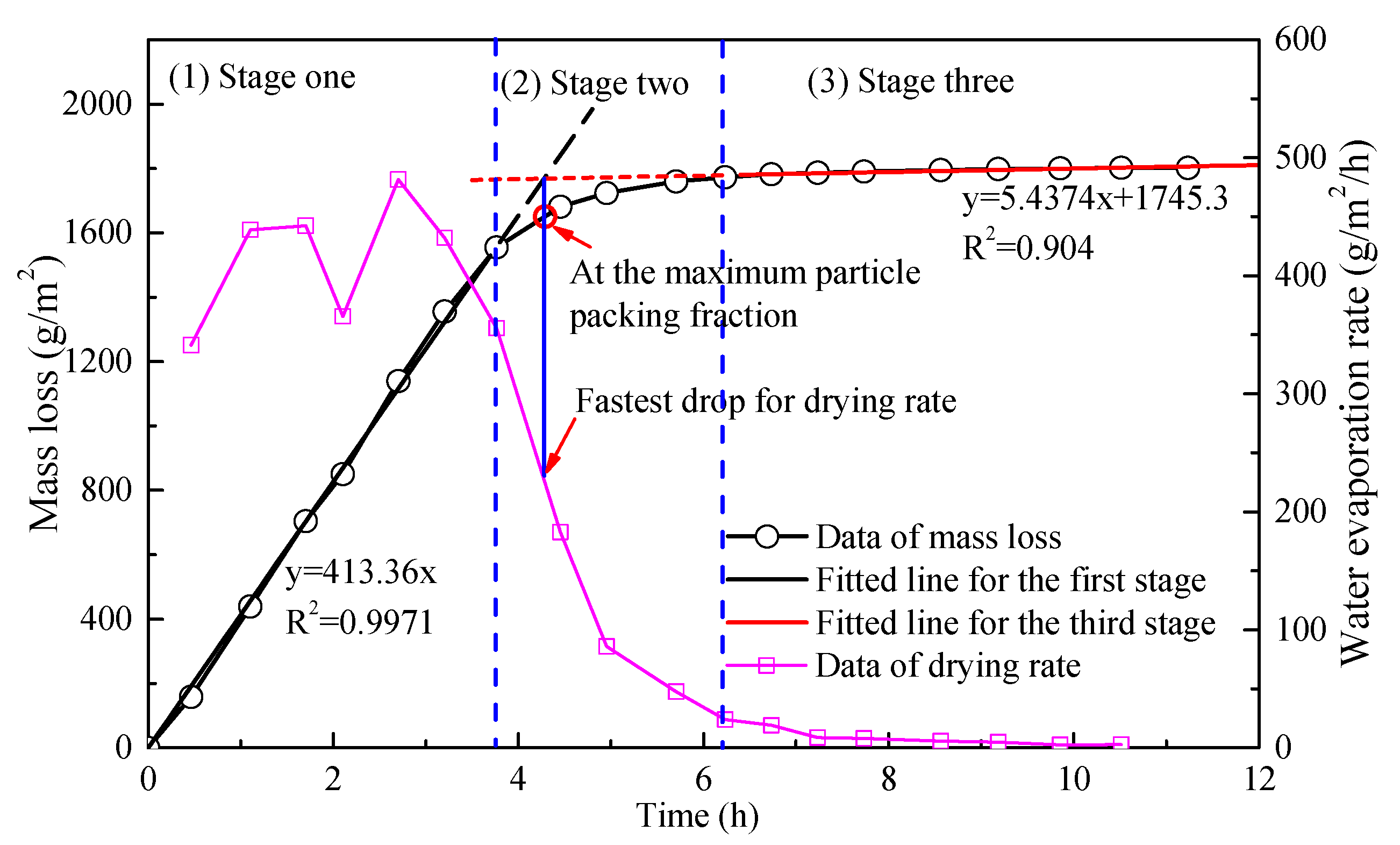
3.2. Quantitative Analysis of the Drying Process
4. Results about the Drying Process of Different Emulsions
5. Discussion
5.1. Effect of Emulsifier on the Drying Behaviour of Bitumen Emulsion
5.2. Effect of Droplet Size on the Drying Behavior of Bitumen Emulsion
5.3. Mechanism Analysis about the Drying Parameters
6. Conclusions
- The drying process of bitumen emulsion, as well as the corresponding bitumen droplets packing evaluation process, can be divided into three stages: (a) an initial high evaporation rate stage in which bitumen droplets are well dispersed; (b) an intermediate stage in which bitumen droplets are contacted, deformed and further coalesced so that the evaporation rate rapidly decreases; (c) a final stage with a continuous bitumen film in which the evaporation rate is near-constant but much smaller than that of the first stage. The boundaries among the three stages can be identified by studying the water evaporation rate.
- The initial evaporation rate differs little for different emulsions, thus the key parameters affecting the drying process of bitumen emulsion are the critical volume fractions of bitumen defining the boundaries among the three stages and the maximum packing fraction of bitumen droplets (i.e., ϕ1, ϕm and ϕ2). Bitumen emulsion with higher values of ϕ1 and ϕm can be dried to a denser state at a high evaporation rate. Bitumen emulsion with a higher value of ϕ2 has low residual water content when the third drying stage begins. Therefore, high values of the drying parameters (ϕ1, ϕm and ϕ2) indicate that bitumen emulsion has a good drying behavior.
- The emulsifier type has little effect on the initial evaporation rate and the key drying parameters (ϕ1, ϕm and ϕ2) of bitumen emulsion. The key drying parameters (ϕ1, ϕm and ϕ2) of bitumen emulsion are highly related to the bitumen droplet size. They are all decreased with the increasing bitumen droplet size. The mechanism for this phenomenon is that the three drying parameters (ϕ1, ϕm and ϕ2) are essentially indexes about the bitumen droplets packing state during drying. Due to Brownian motion, small bitumen droplets can have high motion ability, thus they can easily be densely packed. Overall, decreasing the bitumen droplet size can improve the drying quality of bitumen emulsion.
7. Future Work
Author Contributions
Funding
Data Availability Statement
Conflicts of Interest
References
- Asphalt Institute. A Basic Asphalt Emulsion Manual: Manual Series No. 19 (MS-19), 4th ed.; Asphalt Emulsion Manufactures Association: Lexington, KY, USA, 2008. [Google Scholar]
- Ouyang, J.; Pan, B.; Xu, W.; Hu, L. Effect of water content on volumetric and mechanical properties of cement bitumen emulsion mixture. J. Mater. Civ. Eng. 2019, 31, 04019085. [Google Scholar] [CrossRef]
- Fang, X.; Garcia, A.; Winnefeld, F.; Partl, M.N.; Lura, P. Impact of rapid-hardening cements on mechanical properties of cement bitumen emulsion asphalt. Mater. Struct. 2016, 49, 487–498. [Google Scholar] [CrossRef]
- García, A.; Lura, P.; Partl, M.N.; Jerjen, I. Influence of cement content and environmental humidity on asphalt emulsion and cement composites performance. Mater. Struct. 2013, 46, 1275–1289. [Google Scholar] [CrossRef]
- Graziani, A.; Godenzoni, C.; Cardone, F.; Bocci, M. Effect of curing on the physical and mechanical properties of cold-recycled bituminous mixtures. Mater. Des. 2016, 95, 358–369. [Google Scholar] [CrossRef]
- Wang, Z.; Dai, N.; Wang, X.; Zhang, J.; Guo, H. Laboratory investigation on effects of microwave heating on early strength of cement bitumen emulsion mixture. Constr. Build. Mater. 2020, 236, 117439. [Google Scholar] [CrossRef]
- Miljković, M.; Radenberg, M.; Fang, X.; Lura, P. Influence of emulsifier content on cement hydration and mechanical performance of bitumen emulsion mortar. Mater. Struct. 2017, 50, 1–14. [Google Scholar] [CrossRef]
- Wang, F.; Liu, Z.; Wang, T.; Hu, S. A novel method to evaluate the setting process of cement and asphalt emulsion in CA mortar. Mater. Struct. 2008, 41, 643–647. [Google Scholar] [CrossRef]
- Miljković, M.; Radenberg, M. Characterising the influence of bitumen emulsion on asphalt mixture performance. Mater. Struct. 2015, 48, 2195–2210. [Google Scholar] [CrossRef]
- Saadoon, T.; Garcia, A.; Gómez-Meijide, B. Dynamics of water evaporation in cold asphalt mixtures. Mater. Des. 2017, 134, 196–206. [Google Scholar] [CrossRef]
- Saadoon, T.; Gómez-Meijide, B.; Garcia, A. Prediction of water evaporation and stability of cold asphalt mixtures containing different types of cement. Constr. Build. Mater. 2018, 186, 751–761. [Google Scholar] [CrossRef]
- Goavec, M.; Rodts, S.; Gaudefroy, V.; Faure, P.; Coussot, P. Magnetic resonance imaging of drying bitumen emulsions. Colloid Surf. A Physicochem. Eng. Asp. 2020, 591, 124512. [Google Scholar] [CrossRef]
- Lesueur, D.; Coupé, C.; Ezzarougui, M. Skin formation during the drying of a bitumen emulsion. Road Mater. Pavement Des. 2001, 2, 161–179. [Google Scholar] [CrossRef]
- Ouyang, J.; Meng, Y.; Tang, T.; Miljković, M.; Tan, Y. Characterization of the drying behaviour of asphalt emulsion. Constr. Build. Mater. 2021, 274, 122090. [Google Scholar] [CrossRef]
- Ministry of Transport of the People’s Republic of China. JTG F40: Technical Specifications for Construction of Highway Asphalt Pavements; China Communications Press: Beijing, China, 2004. (In Chinese)
- Ministry of Transport of the People’s Republic of China. JTG E20: Standard Test Methods of Bitumen and Bituminous Mixtures for Highway Engineering; China Communications Press: Beijing, China, 2011. (In Chinese)
- Keddie, J.; Routh, A.F. Fundamentals of Latex Film Formation: Processes and Properties; Springer Science & Business Media: Berlin/Heidelberg, Germany, 2010. [Google Scholar]
- Ouyang, J.; Cao, P.; Meng, Y.; Tang, T. Investigation on the drying and demulsification process of filler—Bitumen emulsion paste. Mater. Struct. 2021, 54, 1–12. [Google Scholar] [CrossRef]
- van Tent, A.; te Nijenhuis, K. The film formation of polymer particles in drying thin films of aqueous acrylic latices: II. Coalescence, studied with transmission spectrophotometry. J. Colloid Interf. Sci. 2000, 232, 350–363. [Google Scholar] [CrossRef] [PubMed]
- Toussaint, A.; Wilde, M.D. A comprehensive model of sintering and coalescence of unpigmented latexes. Prog. Org. Coat. 1997, 30, 113–126. [Google Scholar] [CrossRef]
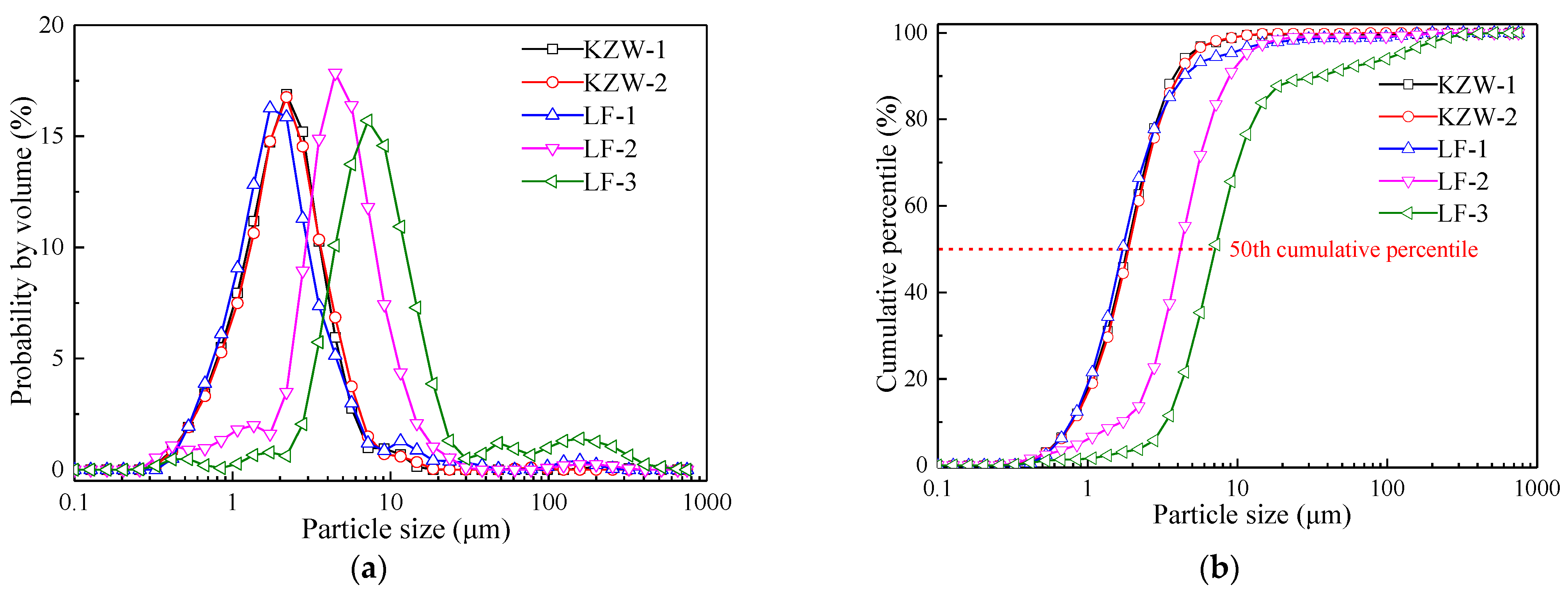
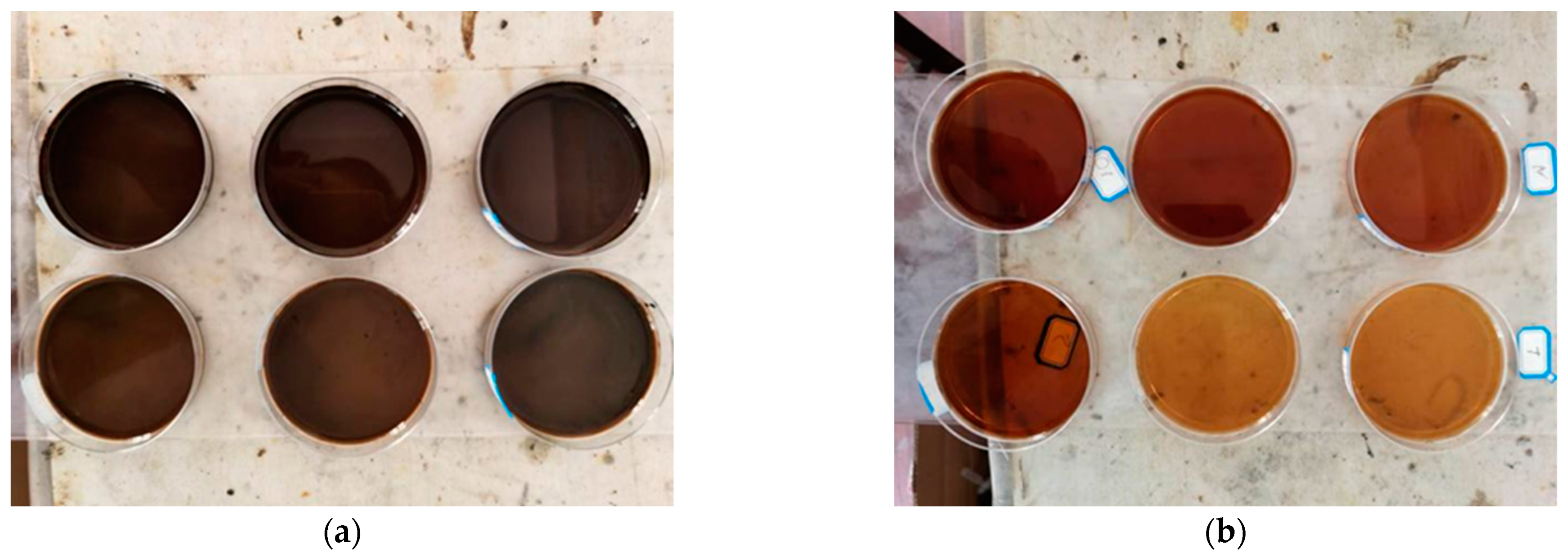
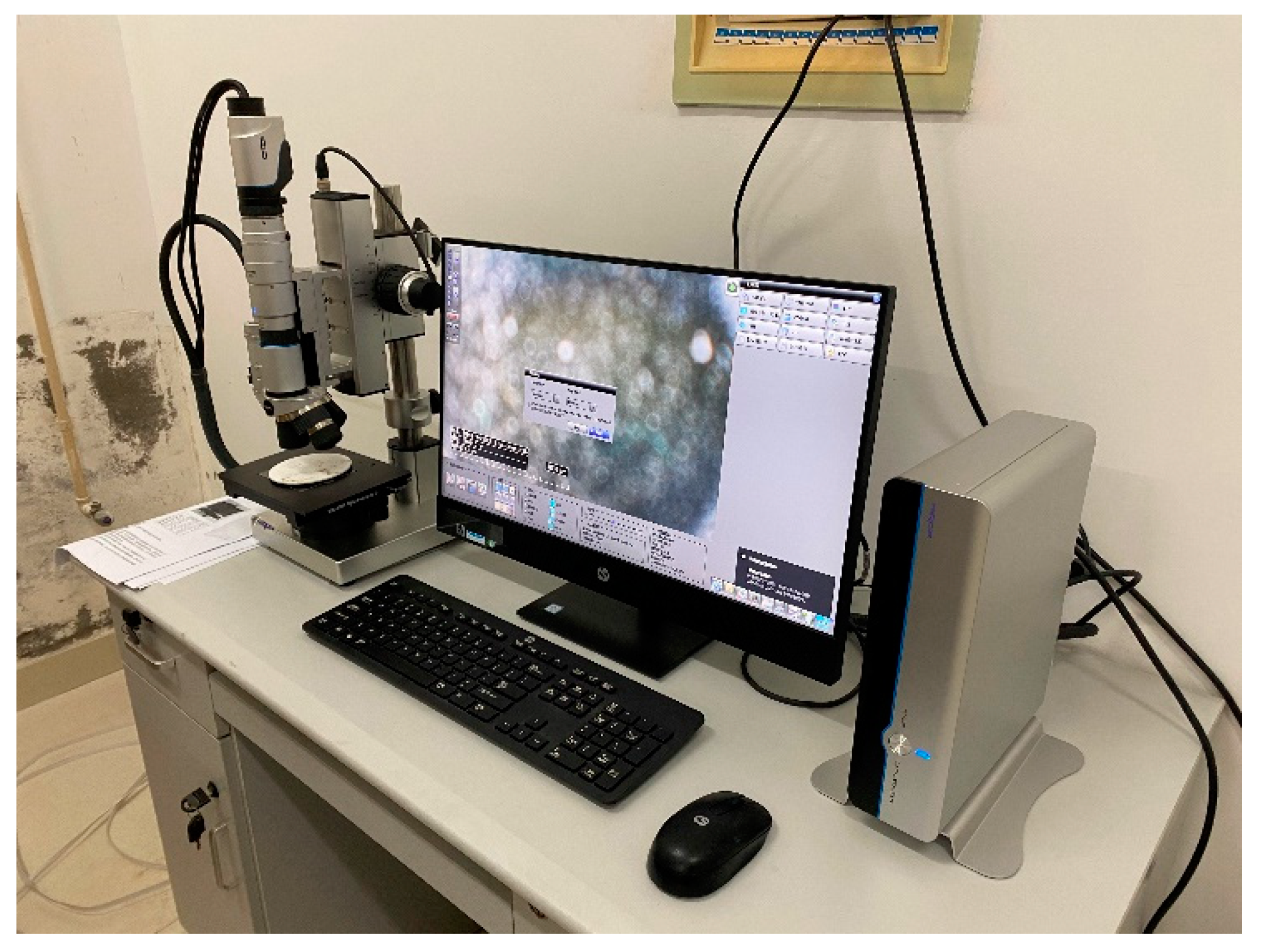

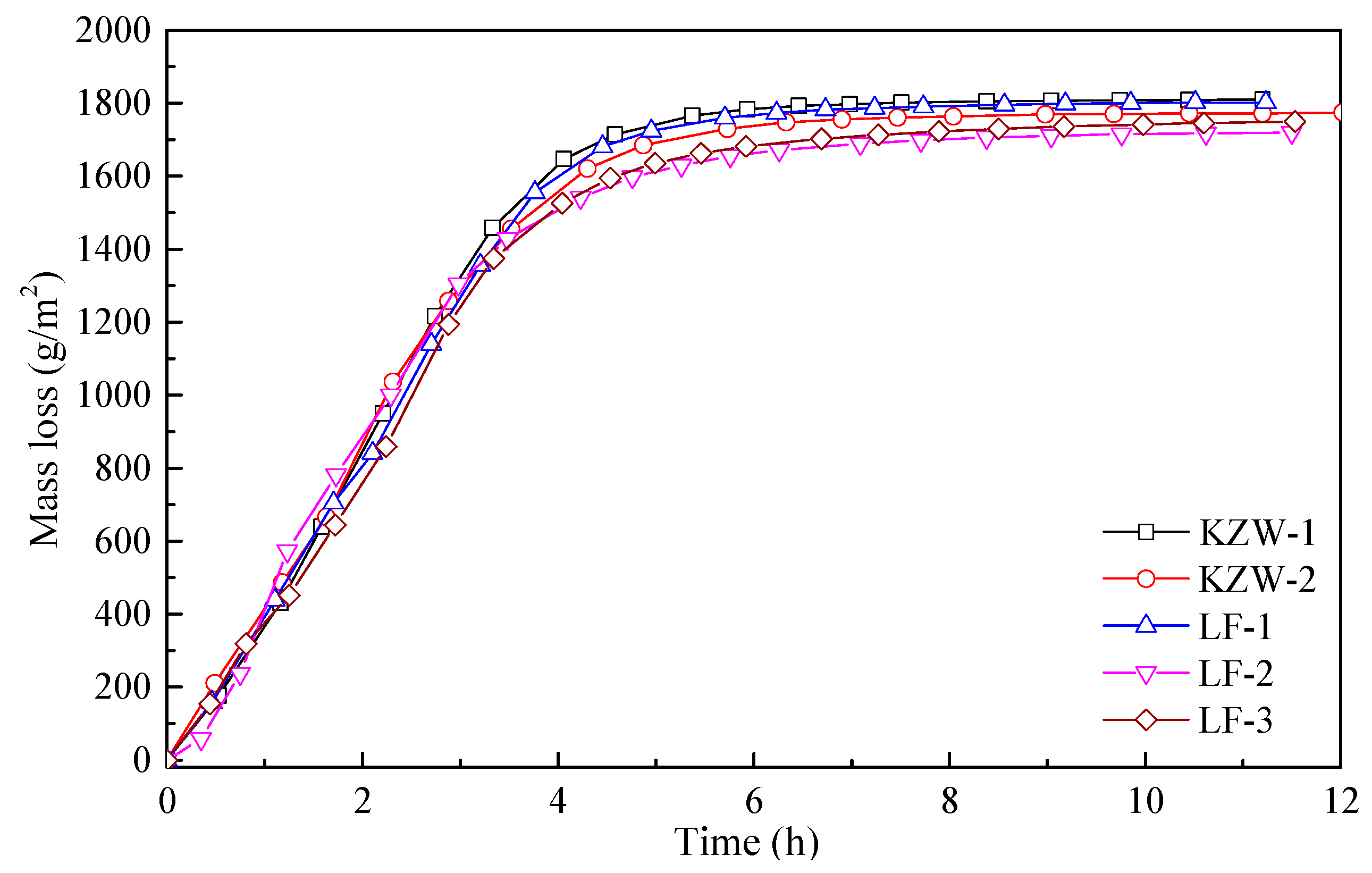
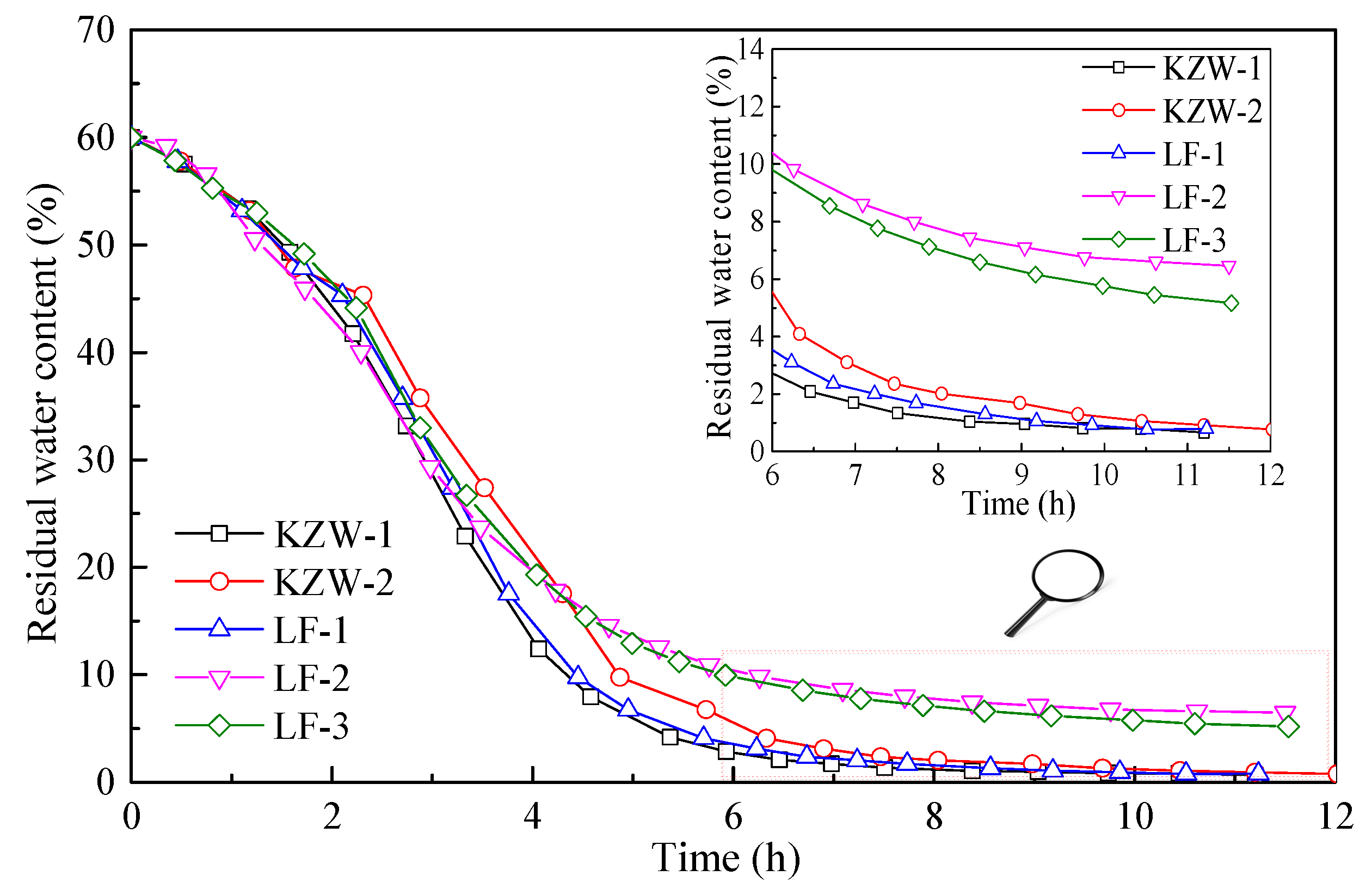

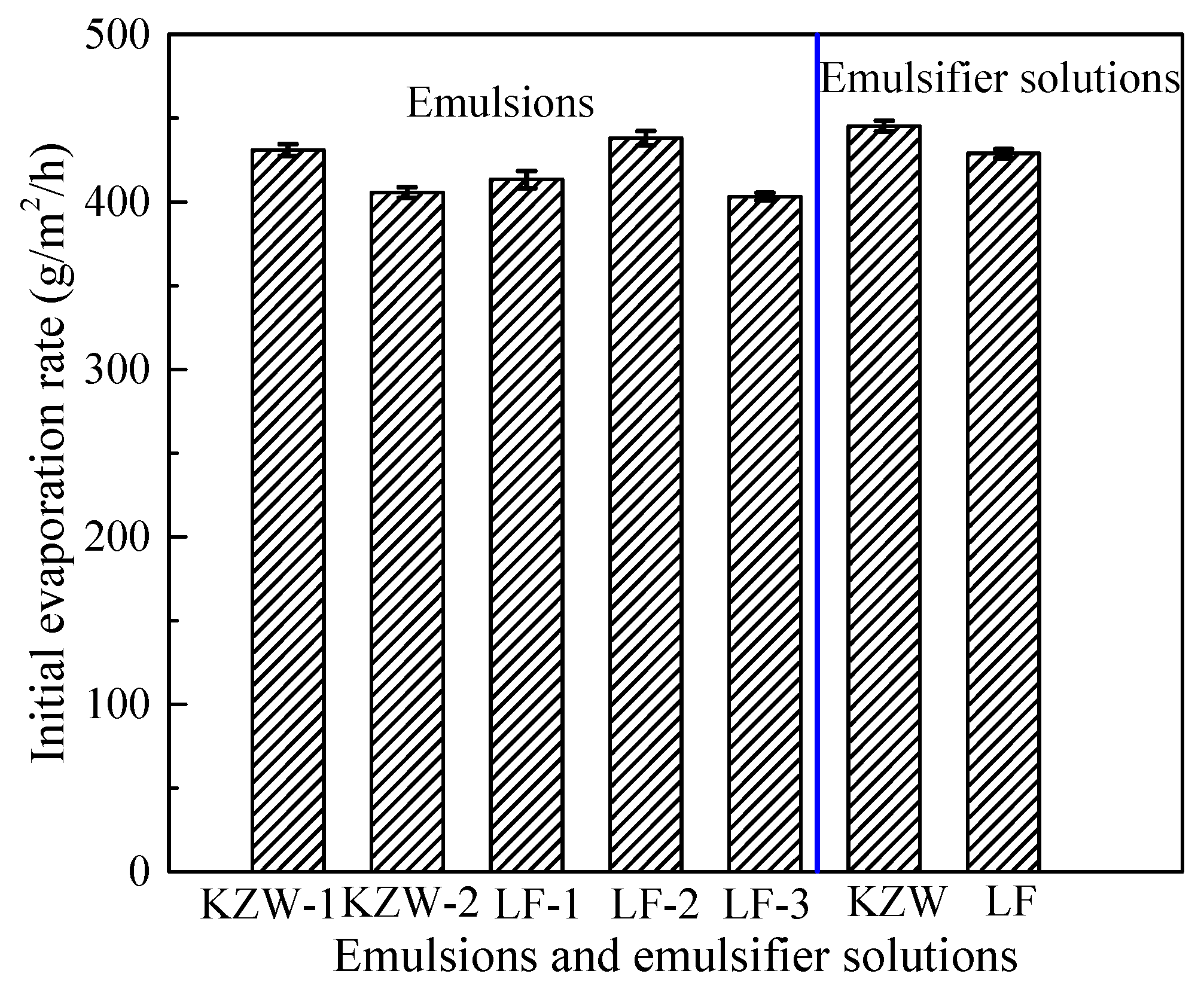
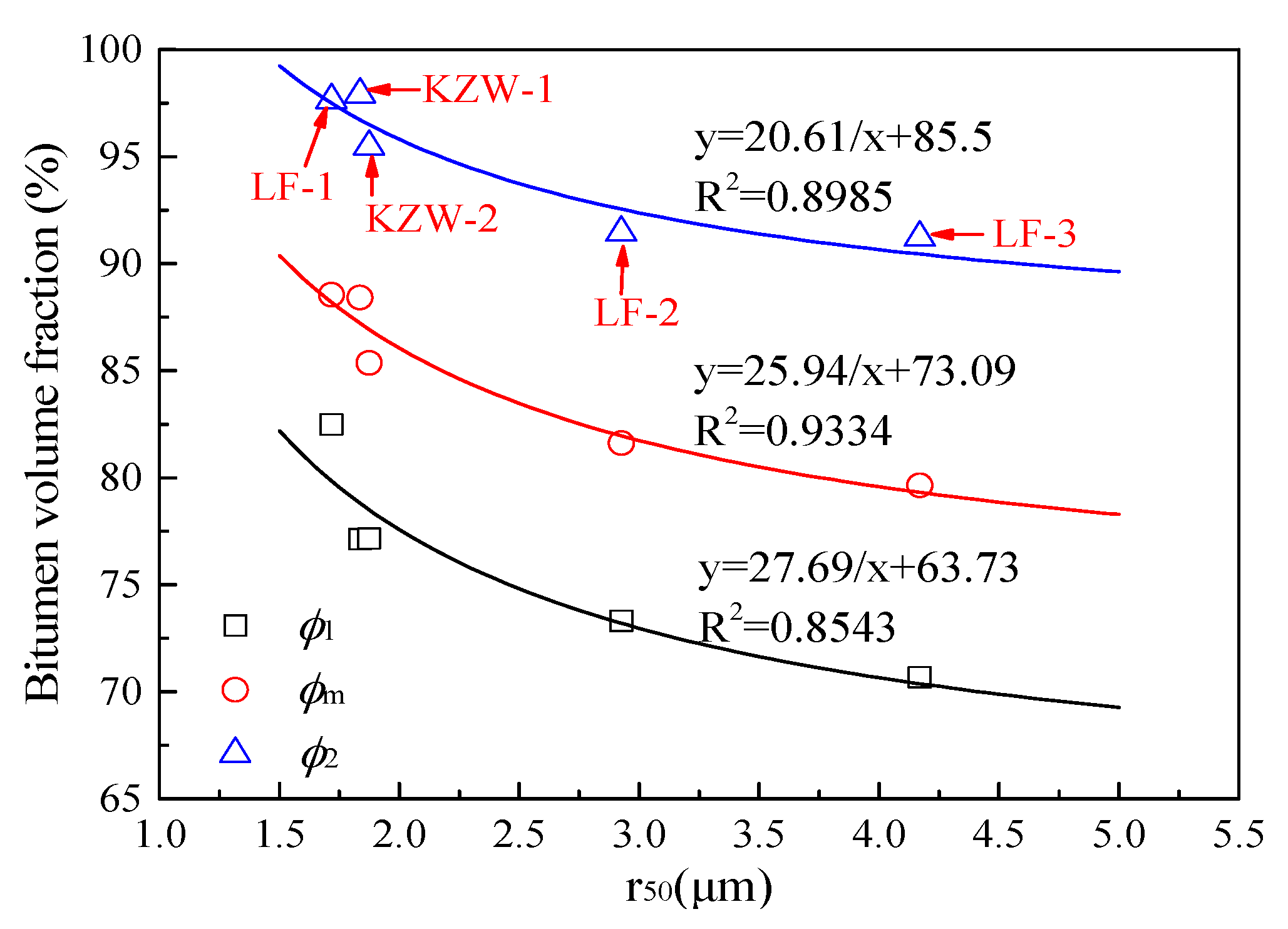

| Property | Test Specifications | Value |
|---|---|---|
| General properties | ||
| Penetration at 25 °C (0.1 mm) | ASTM D 5 | 72 |
| Softening point R and B (°C) | ASTM D 36 | 47.0 |
| Ductility at 15 °C (cm) | ASTM D 113 | >100 |
| Kinetic viscosity at 60 °C (Pa s) | ASTM D 2171 | 227 |
| Flash point (°C) | ASTM D 92 | 276 |
| SARA composition | ASTM D 4124 | |
| Saturates (mass fraction, %) | 13.9 | |
| Aromatics (mass fraction, %) | 41.5 | |
| Resins (mass fraction, %) | 32.4 | |
| Asphaltenes (mass fraction, %) | 12.4 | |
| Emulsion Code | KZW-1 | KZW-2 | LF-1 | LF-2 | LF-3 |
|---|---|---|---|---|---|
| r50(μm) | 1.837 | 1.874 | 1.718 | 2.926 | 4.170 |
| Parameters | Ė0 (g/m2/h) | Time at ϕ1 (h) | Time at ϕm (h) | Time at ϕ2 (h) | ϕ1 (%) | ϕm (%) | ϕ2 (%) |
|---|---|---|---|---|---|---|---|
| Value | 413.36 | 3.76 | 4.29 | 6.23 | 82.48 | 88.55 | 97.64 |
| Sample | Ė0(g/m2/h) | Time at ϕ1 (h) | Time at ϕm (h) | Time at ϕ2 (h) | ϕ1(%) | ϕm(%) | ϕ2(%) |
|---|---|---|---|---|---|---|---|
| KZW-1 | 431.00 | 3.32 | 4.14 | 6.45 | 77.13 | 88.42 | 97.91 |
| KZW-2 | 405.59 | 3.75 | 4.37 | 6.53 | 77.16 | 85.36 | 95.47 |
| LF-1 | 413.36 | 3.76 | 4.29 | 6.23 | 82.48 | 88.55 | 97.64 |
| LF-2 | 438.11 | 2.98 | 3.80 | 7.09 | 70.67 | 79.64 | 91.22 |
| LF-3 | 403.2 | 3.34 | 4.05 | 6.69 | 73.31 | 81.61 | 91.46 |
Publisher’s Note: MDPI stays neutral with regard to jurisdictional claims in published maps and institutional affiliations. |
© 2021 by the authors. Licensee MDPI, Basel, Switzerland. This article is an open access article distributed under the terms and conditions of the Creative Commons Attribution (CC BY) license (https://creativecommons.org/licenses/by/4.0/).
Share and Cite
Li, C.; Ouyang, J.; Dou, F.; Shi, J. Mechanism Influencing the Drying Behavior of Bitumen Emulsion. Materials 2021, 14, 3878. https://doi.org/10.3390/ma14143878
Li C, Ouyang J, Dou F, Shi J. Mechanism Influencing the Drying Behavior of Bitumen Emulsion. Materials. 2021; 14(14):3878. https://doi.org/10.3390/ma14143878
Chicago/Turabian StyleLi, Chun, Jian Ouyang, Fangjie Dou, and Jingtao Shi. 2021. "Mechanism Influencing the Drying Behavior of Bitumen Emulsion" Materials 14, no. 14: 3878. https://doi.org/10.3390/ma14143878
APA StyleLi, C., Ouyang, J., Dou, F., & Shi, J. (2021). Mechanism Influencing the Drying Behavior of Bitumen Emulsion. Materials, 14(14), 3878. https://doi.org/10.3390/ma14143878






